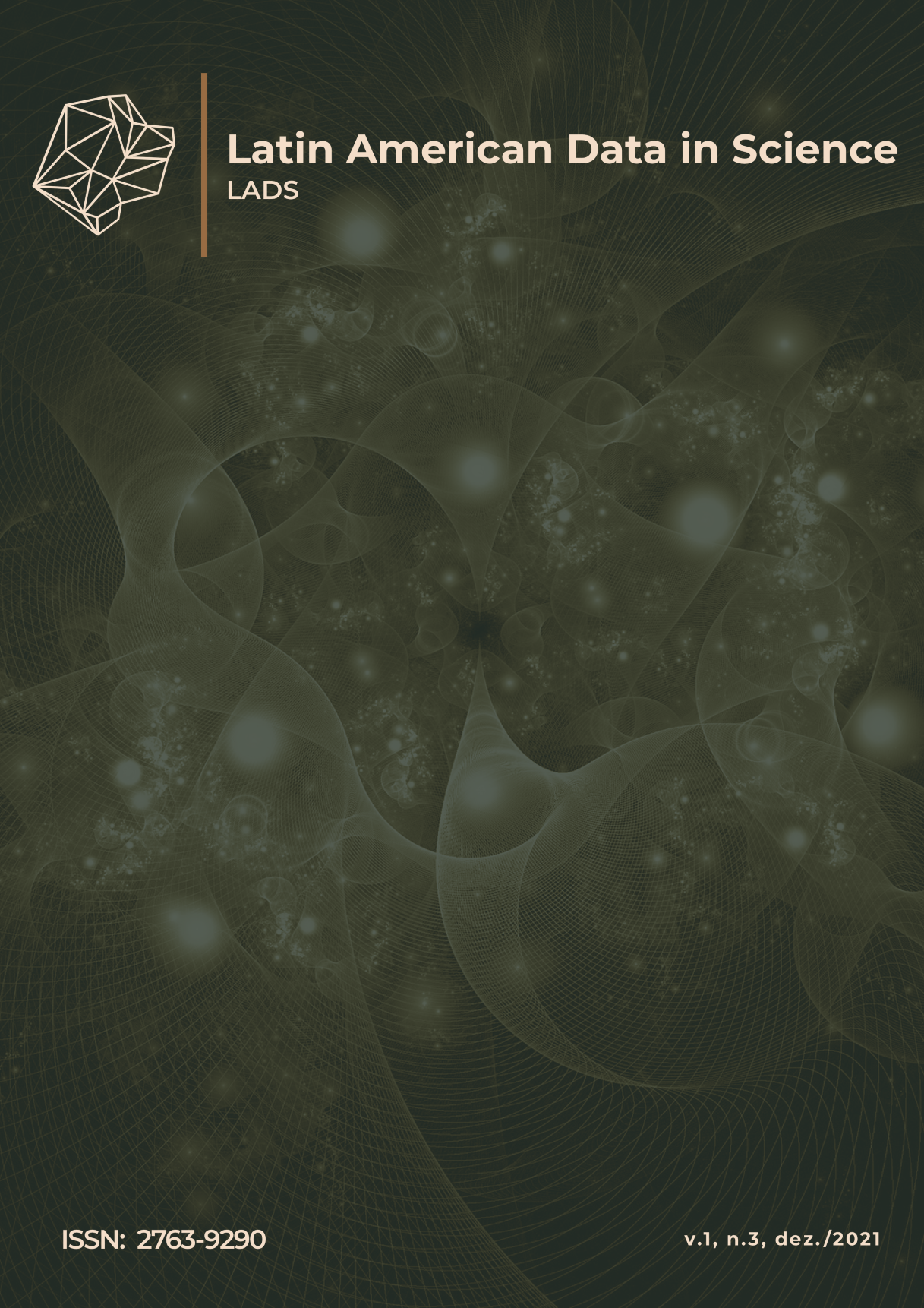Database of extreme waves generated during the passage of a cold front in Rio Grande do Sul coast, southern Brazil
DOI:
https://doi.org/10.53805/lads.v1i3.34Palavras-chave:
WAVEWATCH III model, GFS model, Total wave height, Peak wave period, Rio Grande do SulResumo
This datapaper supports the use of a database generated from wavefield simulations with the WAVEWATCH III model in waters off the coast of Rio Grande do Sul in the South Atlantic Ocean. In the WAVEWATCH III simulations, three domains are generated as a part of a numerical experiment to set up the best configuration. This database includes all input and output files for the two best-fit simulations. Bathymetry and wind files at 10 m above the surface are available as input files. The period of simulation and non-stationary wind data input corresponds to March 22-28, 2016. The date was chosen because it is related to the passage of a cold front through the area of interest. The different parameterizations used and with which good results were obtained in the simulations with the model are also described. The WAVEWATCH III output files contain the spatial and temporal distribution of the wavefield in the area of interest, as well as the outputs for point locations consistent with the location of on-site records. For the two best-fit domains, the following variables were obtained: mean wind speed (m s-1), sea-air temperature difference (°C), wave height (m), mean wavelength (m), mean wave period (s), mean wave direction (degrees), mean directional propagation (degrees) and friction velocity (m s-1). All these variables are provided in NetCDF format and will serve as a reference for future wave modeling work in the region, and the results will be able to be compared with those obtained in the database.
Referências
AMANTE, C.; EAKINS, B. W. ETOPO1 1 Arc-Minute Global Relief Model: Procedures, Data Sources and Analysis, National Geophysical Data Center, NESDIS, NOAA, US Dept. Commerce, Boulder, CO, USA, 2008. DOI: https://doi.org/10.7289/V5C8276M.
BATTJES, J. A.; JANSSEN, J. M. Energy loss and set-up due to breaking of random waves. In: Conference on Coastal Engineering, 16, 1978, Hamburg. Coastal Engineering 1978. Reston: American Society of Civil Engineers, 569-587, 1978. DOI: https://doi.org/10.1061/9780872621909.034.
BORGES, D. M. Sistema de previsão de ondas oceânicas no litoral sul do Brasil e águas adjacentes do Oceano Atlântico Sul, 94p. (Dissertação de Mestrado em Meteorologia) Faculdade de Meteorologia, Universidade Federal de Pelotas, Pelotas. 2019. Available at <http://guaiaca.ufpel.edu.br:8080/handle/prefix/4567>. Accessed in 2021-06-13.
CHALIKOV, D. The parameterization of the wave boundary layer. Journal of physical oceanography, 25 (6), 1333-1349, 1995. DOI:https://doi.org/10.1175/1520-0485(1995)025<1333:TPOTWB>2.0.CO;2
CHALIKOV, D.; BELEVICH, M. Y. One-dimensional theory of the wave boundary layer. Boundary-Layer Meteorology, 63 (1), 65-96, 1993. DOI: https://doi.org/10.1007/BF00705377
HASSELMANN, K. et al. Measurements of wind wave growth and swell decay during the Joint North Sea Wave Project (JONSWAP). Ergaenzungsheft zur Deutschen Hydrographischen Zeitschrift, Reihe A, 8 (12), 95, 1973. Available at <https://pure.mpg.de/rest/items/item_3262854/component/file_3282032/content>. Accessed in 2021-09-02.
HASSELMANN, S. et al. Computations and Parameterizations of the Nonlinear Energy Transfer in a Gravity-Wave Spectrum. Part II: Parameterizations of the Nonlinear Energy Transfer for Application in wave Models. Journal of Physical Oceanography, 15 (11), 1378-1391, 1985. DOI: https://doi.org/10.1175/1520-0485(1985)015<1378:CAPOTN>2.0.CO;2.
SILVA, P. Caracterização do padrão de ondas na costa do Brasil por medio de modelagem numérica, 195p. (Dissertação de Mestrado em Meteorologia) Curso de Pós Graduação em Meteorologia, Instituto Nacional de Pesquisas Espaciais, São José dos Campos. 2013. Available at<http://mtc-m16d.sid.inpe.br/col/sid.inpe.br/mtc-m19/2013/03.12.16.55/doc/publicacao.pdf>. Accessed in 2021-11-22.
SCHULZWEIDA, U. CDO user’s guide. Hamburg: Climate data operators version 1.0.1. Max-Planck-Institute for Meteorology. 2006. Available at: <https://src.fedoraproject.org/lookaside/pkgs/cdo/cdo.pdf/90a93037089dddf6f8919b9d6c30bff7/cdo.pdf>. Accessed in 2021-09-30.
THE WAVEWATCH III DEVELOPMENT GROUP (WW3DG). User manual and system documentation of WAVEWATCH III version 5.16. Maryland: NOAA / NWS / NCEP / MMAB. Technical Note n. 329, 326p + Appendices. 2016. Available at <https://polar.ncep.noaa.gov/waves/wavewatch/manual.v5.16.pdf>. Accessed in 2021-06-17.
TOLMAN, H. L. Validation of WAVEWATCH III version 1.15 for a global domain. Washington DC: NOAA/NWS/NCEP/OMB. Technical Note n. 213. 2002a. Available at <https://polar.ncep.noaa.gov/mmab/papers/tn213/OMB_213.pdf>. Accessed in 2021-10-08.
TOLMAN, H. L. Alleviating the garden sprinkler effect in wind wave models. Ocean Modelling, 4 (3-4), 269-289, 2002b. DOI: https://doi.org/10.1016/S1463-5003(02)00004-5.
TOLMAN, H. L.; CHALIKOV, D. V. Development of a third-generation ocean wave model at NOAA/NMC. In: Proceedings of the International Symposium: Waves-Physical and Numerical Modelling, 1994, Canada. World Meteorological Organizations-Publications-WMO TD. Vancouver: M. Isaacson and M. C. Quick, 725-732. 1994. Available at <https://polar.ncep.noaa.gov/mmab/papers/tn88/OPC88.pdf>. Accessed in 2021-07-25.
TOLMAN, H. L.; CHALIKOV, D. V. Source terms in a third-generation wind-wave model. Journal of Physical Oceanography, 26 (11),2497-2518, 1996. DOI: https://doi.org/10.1175/1520-0485(1996)026<2497:STIATG>2.0.CO;2.
WESSEL, P.; SMITH, W. A global, self-consistent, hierarchical, high-resolution shoreline database. Journal of Geophysical Research: Solid Earth, 101 (B4), 8741-8743, 1996. DOI: https://doi.org/10.1029/96JB00104.
Downloads
Publicado
Como Citar
Edição
Seção
Categorias
Licença
Copyright (c) 2021 Latin American Data in Science

Este trabalho está licenciado sob uma licença Creative Commons Attribution 4.0 International License.





